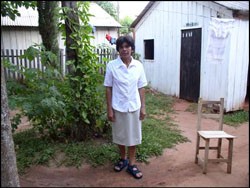
Tomasa, a traditional midwife for the past seven years, lives in a small community called Villa Constitution near Caaguazu City in Paraguay. As a midwife, she has seen much joy which comes with birth but also many problems and trouble.
Her village has had major health problems associated with child birth and emergency deliveries. Maternal death is still a major problem. In 2003, twenty women died during pregnancy due to preventable causes. According to Tomasa, “Once a lady had problems during labor and we didn’t have transportation to get her to a hospital. There was a big storm and we couldn’t get out. The only thing we had was an ox-cart and that was how we took her to the hospital. Our faith in God helped us to save that life.”
Tomasa was very concerned with the health care situation in her village and sought help. USAID started working with eleven traditional birth attendants including Tomasa to strengthen their skills and implement prenatal care, as well as provide timely referrals to public health services when needed. The training is a component of USAID’s PRIME II project to develop a local level maternal health strategy in Paraguay. Assistance is provided to health professionals and traditional midwives like Tomasa to identify signs of risk during pregnancy and labor.
USAID helped the community create a local fund for obstetric emergencies to support a system which alerts hospitals and health centers to respond to obstetric emergencies. Another fund was created as part of the community’s local emergency plan to cover the cost of transportation, medicines or others needs during pregnancy and labor.
USAID also helped to mobilize the community and provide education to raise awareness of the importance of prenatal care and attention of birth skilled professionals during labor. The project has been recognized by the Ministry of Health as the correct approach to reducing the deaths of mothers during birth The National Maternal Mortality Surveillance Committee is exploring the possibility of expanding the project to other areas.
After two years, 100% of the traditional birth attendants have been trained and a formal referral system was established with public health facilities. Public health professional know the traditional birth attendants like Tomasa and will receive patients referred by them.
Tomasa now sees her midwife role as part of a larger health sector chain. “Everything changed since I first became acquainted with the PRIME project,” she said. “Now I feel more secure. I’m aware of the need and importance of making a referral to a formal health facility for pregnant women who show signs of risk during labor.”







Comment
Make a general inquiry or suggest an improvement.